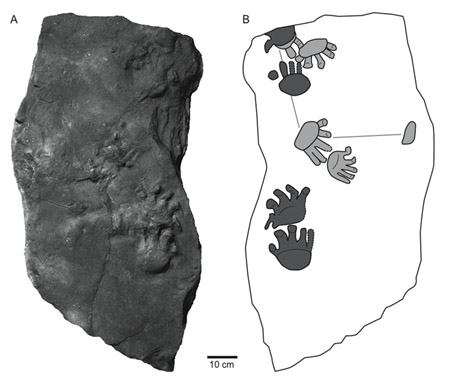ROM Research: Permian trackways from P.E.I.
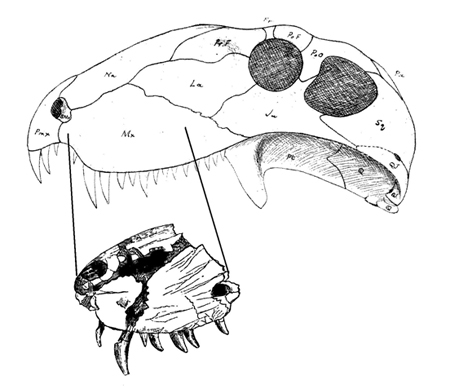
By Kirstin Brink and Jessica Hawthorn, PhD candidates, University of Toronto
Many impressive fossils have been found in eastern Canada: the spectacular Precambrian fossils of Mistaken Point, Newfoundland; the Carboniferous early amniotes (egg-laying vertebrates) from the Joggins Fossil Cliffs, Nova Scotia; and the Jurassic dinosaurs at the Bay of Fundy.
The fossils of Prince Edward Island (PEI) are less well known, and are often overshadowed by those in neighbouring provinces. However, the fossil initially touted as ‘Canada’s first dinosaur’ was found in PEI. The specimen, named Bathygnathus borealis by Joseph Leidy in 1854, was described as the dentary (a lower jaw bone) of a Triassic meat-eating dinosaur. It wasn’t until years later that geologists realized that the rocks of PEI were from the early part of the Permian Period – older than the oldest dinosaurs. In 1905, E. C. Case and F. von Huene, both palaeontologists specializing in Permian-aged fossils, independently realized that the fossil of Bathygnathus wasn’t the lower jaw of a dinosaur at all, but was actually the maxilla (an upper jaw bone) of an early synapsid.
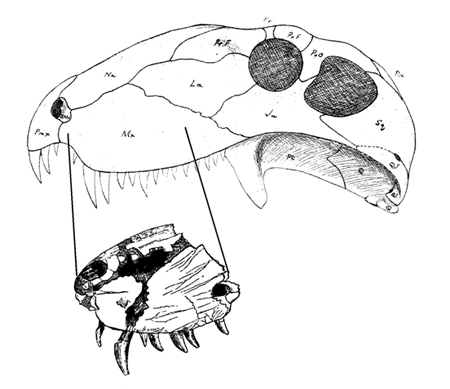
Synapsids are amniotes with a single temporal fenestra in the skull (an opening for the attachment of jaw muscles). The only synapsids that survive today are the mammals, but the early synapsids were much more reptile-like in appearance. Arguably the most famous early synapsid is Dimetrodon, a large sail-backed carnivore from the Early Permian Period. Bathygnathus is now thought to have been a synapsid like Dimetrodon, and these two genera were probably very closely related to each other.
Other terrestrial vertebrates from the Early Permian period include a group of large herbivorous amphibians called diadectids. Wann Langston, a paleontologist with extensive experience collecting fossils in Canada, found a few small, incomplete fossils from this group of animals in PEI. However, the record is poor, so little is known about what other large animals may have lived alongside Bathygnathus (and what might have been its dinner!).
Luckily, there are trackways preserved from PEI. Trackways provide important information that helps palaeontologists interpret which animals were living in particular environments when fossil bones are not available. Since it is very rare to know what organism made a particular type of footprint, trace fossils are given their own scientific names. Usually, fossil footprints are found in different places than fossil bones, because different types of fossilization processes preserve them. Some tracks from PEI have been described as belonging to small animals, probably the early ancestors of modern reptiles.
A New Discovery
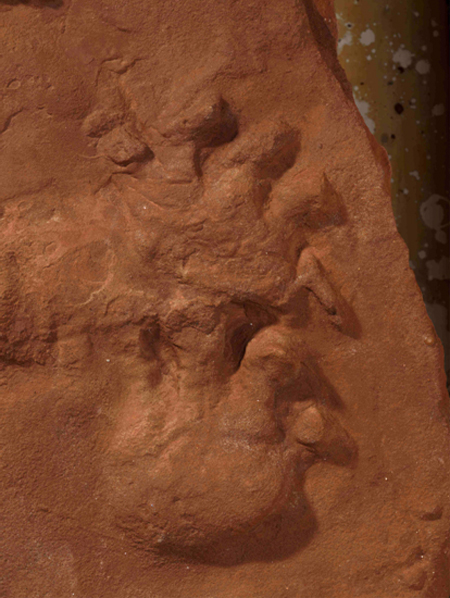
Sometime before the year 2000, some local Islanders were walking along the beach near Eldon, PEI. There, they discovered a very large slab of rock near the shore that had fallen from the cliffs above. On it, they noticed some footprints. They were large, about the size of an adult human handprint, with bulbous fingertips. Not knowing what they were, and considering the weight of the slab, they decided to move it to a nearby gas station, where it remained on display near the pumps for several years.
Another local fossil enthusiast with ties to the Royal Ontario Museum heard of the specimen, and decided to go see it. Realizing that it was something he had never seen before from PEI, he convinced the collectors to donate it to the museum. The footprints were initially identified as Dimetropus, which is thought to have been made by Dimetrodon. The tracks then sat in the collections of the ROM for 10 years.
When working on our PhD research at the University of Toronto in 2010, we were alerted to the presence of the trackways by Kevin Seymour, the vertebrate palaeontology collection manager at the ROM. Intrigued, we decided to study the tracks with the curator of vertebrate palaeontology, Dr. David Evans. Upon discovering that the tracks were not actually Dimetropus, but Ichniotherium, which are attributed to diadectids, the large-bodied Permian herbivores, we were intrigued. We decided to describe the trackways, and found that the PEI footprints were the largest Ichniotherium footprints ever found! We also found a small trace fossil called Striatichnium bromackerense, which looks like scratch marks made by an invertebrate, such as a shrimp.
Excited by how much we learned from a single specimen, we decided to return to the locality in PEI to see if we could find more. We were granted a scientific research permit from the provincial government of PEI to visit sites along the southern and northern coasts of the island, where Bathygnathus, other tracks, and the fossils that palaeontologist Wann Langston described had been collected.
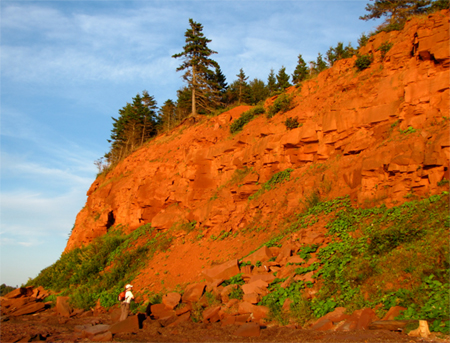
Fieldwork in Prince Edward Island was very different from participating in dinosaur excavations in the badlands of Alberta and Saskatchewan or looking for fossils in the Rocky Mountains – we had to pay close attention to the tide schedule! Most of the exposed Early Permian rocks are along the coastline, and we had to be sure not to get trapped when the tide came in. We were able to find a few trackways from invertebrate trackmakers, but nothing as impressive as the large tracks of Ichniotherium found previously, and no skeletal material.
The description of these tracks is a small step towards understanding the terrestrial palaeoenvironment of the Early Permian in PEI, and the animals that lived there. Future fieldwork in PEI will help reveal the diversity of Permian organisms by discovering more animals like Bathygnathus, Dimetrodon, and Diadectes, and how they lived. The Ichniotherium trackway will be put on display at the ROM in the upcoming early life exhibit.
Reference: Brink, K. S., J. R. Hawthorn, and D. C. Evans. 2012. New occurrences of Ichniotherium and Striatichnium from the Lower Permian Kildare Capes Formation, Prince Edward Island, Canada: Palaeoenvironmental and biostratigraphic implications. Palaeontology 55(5):1075–1090. DOI: 10.1111/j.1475-4983.2012.01178.x
